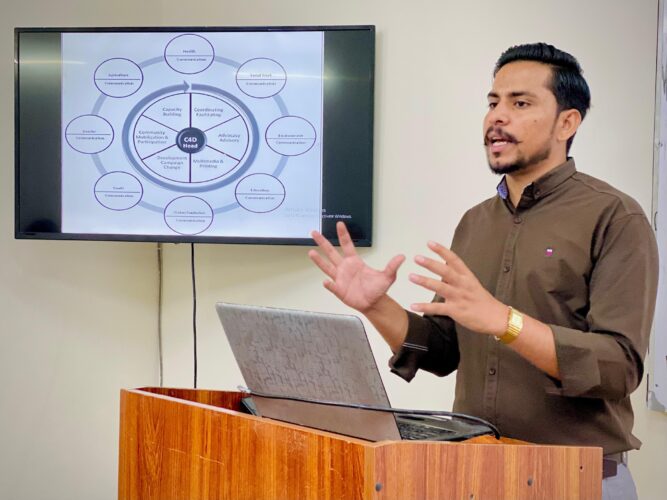Agriculture is not only the backbone of economies of developing countries but also supports livelihoods and food security. Despite its importance, this sector faces numerous challenges that limit agricultural productivity and threaten its sustainability. The population of Pakistan is 228.9 million in 2025 and is expected to reach 250.2 million in 2050. This rapid growth in population has increased food demand. The agricultural sector of Pakistan needs to place emphasis on potential productivity to meet the challenges and fulfill the demands of its ever-growing population for food and fiber. Climate change, outdated farming practices, and inadequate research and extension services are some of the most common hurdles faced by agricultural communities. Traditional approaches to agricultural development are no longer sufficient in such a complex situation. There is a growing need for innovative solutions to empower farmers and other stakeholders involved in agricultural and rural development.
Communication for Development (C4D) emerges as a vital tool in this context and offers an innovative approach to enhance productivity through participation, integration and communication capacity building. C4D is more than just a method to disseminate information; it provides everyone with a chance to participate in the development process. It is a two-way process that emphasizes dialogue, collaboration, and engagement among all stakeholders involved in the agricultural value chain. It ensures farmers, women, youth, extension workers, policymakers and all other actors are heard and considered in decision-making.
Food and Agriculture Organization (FAO) of the United Nations is one of the pioneer international agencies that pointed out the dire need to implement communication for development (also known as comdev) in developing countries to support the agricultural and rural development process. FAO defines comdev as a “result-oriented communication process based on dialogue and participation that can maximize the impact and sustainability of development initiatives, facilitate knowledge sharing, informed decision making and collective action.” C4D integrates various strategies including participatory techniques, community media and digital tools to reach an audience effectively to address different issues related to agriculture, environment and health, etc.
One of the primary ways to enhance agricultural productivity is through effectively disseminating information and knowledge among farming communities. Farmers in Pakistan often face challenges due to limited access to latest information on best practices, improved seeds, and market opportunities. Since 2000, Pakistan’s agriculture growth rate has been on the decline compared to the previous four decades. Within the crop sector, major cash crops such as rice, sugarcane, and cotton have faced significant challenges. The C4D approach can help disseminate information on causes of low productivity and growth rate by utilizing multiple channels especially community radio and participatory video. For example, rural radio such as Kagadi–Kibaale Community Radio (KKCR) in Uganda has been used to educate farmers on better farming techniques, climate-resistant seed varieties, and innovations in product sales and marketing.
Extension workers play an important role in bridging the gap between farmers and researchers. They are responsible for providing necessary support and guidance to agricultural communities. In Pakistan, Extension workers face different challenges including limited capacity, unfamiliarity with ICTs, weak collaboration among agricultural stakeholders, and reliance on top-down communication. The main reason behind these problems is that Extension Field Staff is mostly trained in agricultural sciences. C4D can play an important role in improving the agriculture extension services by introducing them with social and behavioral strategies. Incorporating C4D principles through training programs can help extension field staff develop skills and competencies in two-way communication strategies and interagency collaboration. Dr. Robert Agunga’s C4D model provides guidelines to improve agriculture extension by establishing C4D Centers at divisional levels and hiring C4D Practitioners at district levels. Better decision making as a result of community mobilization and farmer participation in agricultural activities can lead to higher yield.
Pakistan’s irrigation system is failing due to wide spread water wastage as a result of inefficient techniques like flood irrigation, lack of maintenance of infrastructure, inequitable water distribution and insufficient water management. The country needs to draw lessons and learn from other countries that have successfully implemented irrigation improvement projects. Participatory Irrigation Development Project (2009) with funding from the World Bank is the best example of how the Philippine government successfully launched a participatory strategy to improve irrigation service delivery, leading to increased agricultural production. This initiative consulted and engaged indigenous people in decision making, built on local/cultural knowledge, and conducted participatory monitoring and evaluation. These approaches ensure that the voices of farmers and other agricultural stakeholders are heard and their needs are prioritized in designing and implementing interventions.
Pakistan is one of the top countries affected by climate change and agriculture sector is badly affected by it. Pakistan’s Punjab in 2025 faces its worst floods in decades as more than 3,000 villages have been impacted till date, which means 3.3 million rural people. → This catastrophic flooding not only disrupted major crops rice and cotton but also made the next planting season uncertain. The use of Information and Communication Technologies (ICTs) in agriculture could have avoided such extensive damage by sharing timely forecasts and early warnings. C4D supports the integration and adoption of ICTs among farming communities to provide access to weather forecasts, climate resilient agricultural practices and market information. In India, E–Choupal has become a revolutionary model of ICT integration in agriculture. Under this project, farmers have been provided with internet access and digital kiosks for weather information, up-to-date market information and greater control over their sales. While in Pakistan, Bakhabar Kissan, a pioneering ICTs Platform, has made a significant contribution to enhancing agricultural yield by offering services such as weather forecasts, production technology, and advice through calls, messages and digital application. Pakistan needs more public sector ICT initiatives rooted in C4D principles for agricultural growth and rural development.

No doubt that C4D offers many benefits but its implementation is not possible without challenges. Resistance to change, lack of awareness among stakeholders, less institutional support, and low accountability are major factors that can hinder the effectiveness of C4D projects, as observed recently when Arid Agriculture University tried to pilot test a Communication for Development framework developed by Dr. Robert Agunga. However, despite all these hurdles, Communication for Development is the only way forward to fuel the engine of rural development in Pakistan. Recent advances in technology are likely to play an important role in shaping C4D strategies. Additionally, the growing emphasis on sustainability and climate resilience might drive the continuity of C4D initiatives that address environmental challenges and promote sustainable rural development.
Prioritizing and integrating C4D strategies in national agricultural frameworks are essential to ensure that farmers are equipped with knowledge, tools and resources they need to adapt to changing conditions. Government should allocate proper funding for C4D initiatives, particularly those focused on capacity building of extension workers, participatory approaches, and climate change. It is crucial for policymakers, non-governmental organizations, the public and private sector, and other agricultural stakeholders to learn from the experience of international development organizations and invest in these initiatives to maximize the impact of C4D.
Communication for development is a powerful tool for enhancing agricultural productivity by facilitating knowledge dissemination, capacity building of stakeholders, participatory approaches and use of ICTs. Fortunately, universities in Pakistan are increasingly recognizing the importance of communication for development and initiating degree programs and research projects in this multi-disciplinary subject. Noteworthy examples include the Department of Media and Development Communication at University of the Punjab and the Agricultural Extension Department at Arid University. Embracing C4D as a core component of agricultural strategies and fostering collaboration are essential steps to achieve shared goals. By doing so, we can improve agricultural productivity and contribute to sustainable development in Pakistan.
RCS blog contributed by Aqeel Randhawa.
He is the founder of the Communication for Development Center, a consultancy firm based in Pakistan. He is currently also part of the visiting faculty in the Department of Media and Development Communication at Punjab University.
Read his past RCS blog: The Rise of Development Communication in Pakistani Universities: A New Path to Sustainable Development
Get in touch with him through: Email: aqeel@c4dc.org; Phone: +923451085150; LinkedIn: Aqeel Randhawa
Contribute your own RCS blog now through this link: https://bit.ly/RCSBlogSubmit


Comments are closed, but trackbacks and pingbacks are open.